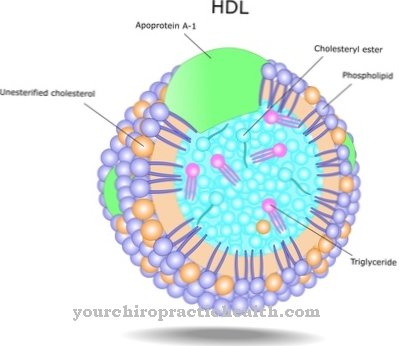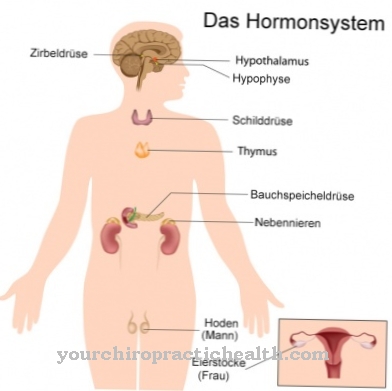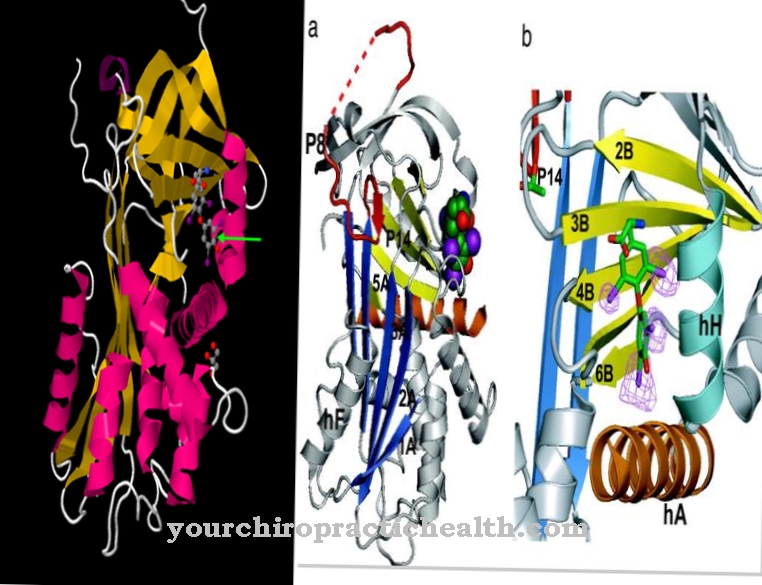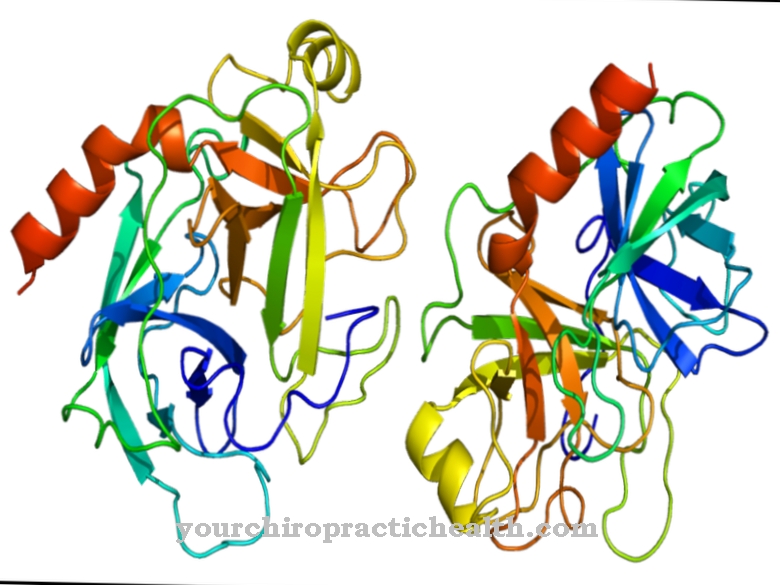Thyrotropin, also Thyroid stimulating hormone called, is a control hormone that regulates the activity, hormonal production and growth of the thyroid gland. It is released and regulated through interaction with other hormones. Over- or underproduction has far-reaching effects on the function of the thyroid gland.
What is thyrotropin?

Thyrotropin is one of the hormones, these are biochemical substances that have an effect on specific cells or organs and are thus involved in the regulation of the circulatory system and other functions of the organism.
In the case of thyrotropin, that regulated organ is the thyroid gland. From a chemical point of view, thyrotropin is a glycoprotein, i.e. a macromolecule that consists of a protein with covalently attached carbohydrate groups. This protein consists of two subunits called the alpha and beta subunits. They differ in the number of amino acids they contain.
The beta subunit, which contains 112 amino acids, is specific for this hormone, while the alpha subunit with its 92 amino acids is also found in a similar form in other, related hormones. These related hormones include human chorionic gonadotropin, follicle-stimulating hormone, and luteinizing hormone.
Production, Education & Manufacturing
Thyrotropin is synthesized in the thyrotropic cells of the anterior pituitary gland. This is an area of the diencephalon that is responsible, among other things, for controlling the autonomic nervous system. The synthesis of thyrotropin is controlled by complex interactions between various other hormones. The most important of these hormones is thyroid liberin.
This is formed in the hypothalamus, also an important part of the diencephalon, and then passes through a special vascular system to the anterior pituitary gland. Depending on the concentration of thyroliberin, this stimulates the production and release of thyrotropin. The interaction with thyroid hormones, on the other hand, can lead to the formation of thyroid liberin being suppressed, which also affects the synthesis and secretion of thyrotropin.
Function, effect & properties
Once released in the hypothalamus, thyrotropin is released into the bloodstream. One of the functions is the controlled release of lipids in adipose tissue. The actual target organ, however, is the thyroid gland. Here, thyrotropin acts on the cells of the thyroid gland by stimulating increased cell division.
The thyroid's iodine uptake also increases. This function of thyrotropin to increase the iodine uptake of tissues is used in the therapy of thyroid carcinomas. Special drugs that contain an artificially produced form of thyrotropin, the so-called recombinant human thyrotropin, are used as part of radioiodine therapy. This means that radioactive iodine is absorbed more quickly by the diseased cells.
As a further effect of thyrotropin on the function of the thyroid gland, the production of the thyroid hormones thyroxine and triiodothyronine is increased. These two peripheral hormones contain a lot of iodine and are also essential for the energy metabolism. As reaction partners, they are involved in important reactions such as glycolysis and gluconeogenesis.
With a sufficiently high concentration, they also suppress the formation of thyroid liberin through negative feedback. This indirectly inhibits the synthesis of thyrotropin. On the other hand, if the concentration of peripheral thyroid hormones is low, the formation of thyroid liberin is stimulated. This ensures that the concentration of thyroid hormones is always appropriate to the need, because production is very energy-intensive. This balance of thyroid hormones can be disturbed by an increased or decreased production of thyrotropin.
Illnesses, ailments & disorders
If the production and release of thyrotropin is too low, a so-called pituitary hypothyroidism occurs. The thyroid can no longer absorb iodine or produce thyroid hormones. This suppresses growth and makes the thyroid increasingly smaller. This can lead to stunting. In this case, it is referred to as secondary hypothyroidism.
With an increased production and release of thyrotropin, on the other hand, the iodine uptake and hormone production of the thyroid gland is pathologically increased. This is often caused by an adenoma, a benign swelling of the tissue that is responsible for the increased thyrotropin production. The increased production of thyroid hormones is known as pituitary hyperthyroidism or secondary overactive thyroid. These two forms of disease are to be described as secondary because they are not caused by changes in the thyroid gland itself.
Rather, they result from the indirect influence of thyrotropin on the function of the thyroid gland. Both forms are rarer than the primary dysfunction. An increased level of thyrotropin in the blood can also indicate an iodine deficiency. After the thyroid gland has been removed due to cancer, it is also important to ensure that the production of thyrotropin is kept low.
This is because its mode of action of stimulating thyroid tissue to grow is not canceled even if there is no thyroid gland. As a result, malignant thyroid tissue can form, which in turn can lead to carcinomas.













.jpg)

.jpg)
.jpg)











.jpg)